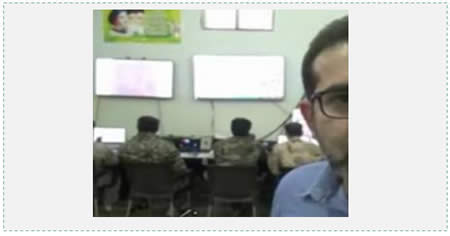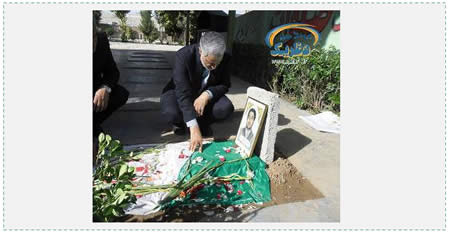
The Syrian-Iranian operations room set up in Aleppo before the Syrian army attack, waged with the support of Iranian fighters. The poster in the upper left hand corner shows Khamenei, Khomeini and an unidentified third person. The Persian text at the right reports on the operation room's activities (Fars News, October 22, 2015).
Overview
1. Since the outbreak of the Syrian civil war in 2011, the Qods Force of the Iranian Islamic Revolutionary Guards Corps (IRGC), under the command of Qasem Soleimani, has led the effort to keep Damascus and strategic Syrian strongholds in the north from falling into the hands of the rebels, and to prevent the collapse of the Syrian regime. The Iranians have supported the Syrians with arms and guidance, and have sent Iranian advisors and fighters to Syria for close cooperation with the Syrian army and security forces. Iranians have also employed Shi'ite proxies in the fighting in Syria (including Hezbollah and foreign Shi'ite fighters from Iraq, Afghanistan and Pakistan).
2. Iran's involvement in Syria, like its involvement in Iraq, Lebanon and Yemen, had, until recently, involved a few hundred Iranian advisors and several thousand Shi'ite fighters directed by the Qods Force. The IRGC's presence was limited and its function was mainly advisory. The Iranians did not employ organic military units against the rebels and usually did not involve themselves directly in the fighting (although on occasion IRGC operatives found themselves in the crossfire between the Syrian regime forces and the rebels, which led to their deaths).
3. The military successes of ISIS, Al-Nusra Front and other rebel organizations in northwest Syria raised doubts among the Iranians as to Assad's ability to survive over time as president of Syria. That led Iran to significantly increase its support for the Syrian regime, whose control was waning in regions vital to Syrian interests ("Little Syria"). Thus in the middle of September 2015 Iran increased the number of its forces in Syria, apparently dispatching between 1,500 and 2,000 fighters, some of them taking an active part in the fighting. The reinforcements, composed of IRGC and Shi'ite foreign fighters from Afghanistan and Iraq, were sent to support the Syrian army in its attack in northern Syria at the beginning of October 2015.
4. The Syrian army attack, with the combined aid of Iranian and Hezbollah fighters and Russian aerial support, began on October 7, 2015. Ajoint Syrian-Iranian operations room was set up in the Aleppo region to coordinate and command the attack forces. Fighting was waged in the areas of Hama, Idlib and Aleppo to relieve the strategic pressure exerted by Al-Nusra Front and its allies on the Syrian regime's vital strongholds in Latakia and along the coast. Apparently, at first the Syrian army had local successes, but at the end of October the attack petered out and the rebel organizations, including Al-Nusra Front and ISIS, gained the initiative. Battles are currently being fought in the rural areas south of Aleppo, north of Hama and around Idlib, and so far they have not been won.
5. The fierce battles in northern and western Syria caused the Iranian forces heavy losses: since the beginning of the ground offensive in the north at least 53 Iranian IRGC fighters have been killed in Syria (as of November 15, 2015).[1] That is a sharp increase in the number of Iranian dead relative to the period before the beginning of the ground offensive. The large number of Iranians killed in a short time, and the strikingly large number of officers (including high-ranking officers), would seem to indicate that IRGC fighters are on the front line of the current ground offensive.

Qasem Soleimani, Qods Force commander, at the grave of an IRGC fighter killed in Syria (Afsaran.ir, April 14, 2015).
6. An analysis of the profiles of the Iranians killed indicates that the overwhelming majority belonged to the IRGC's regular fighting units. That means that most of Iran's military involvement in Syria is based on those units, at the expense of the Qods Force. While the Qods Force commander, Qasem Soleimani, personally leads the attack in northwest Syria and coordinates with the Syrian army, the IRGC and Hezbollah, the main thrust is carried out by fighters in the regular IRGC units (infantry, armored corps and special forces). The relatively large size of those units (compared with the Qods Force, which is relatively limited in size) makes it possible for them to send many more fighters to the battle zones and to provide a response for the constraints on Iran in Syria.
7. The profiles of the Iranians killed also indicate the preponderance of fighters in special units among the forces sent to Syria. They include the Saberin brigade, the Ansar al-Mahdi security unit, the 33rd Airborne Brigade and the 154th Battalion. That would seem to indicate an Iranian effort to send trained fighters with special skills to carry out special missions, possibly including gathering intelligence. The Shi'ite foreign fighters, especially those from Afghanistan in theFatemiyoun Brigade, continue to fight on the front lines of the ground offensive and to bear the brunt of the fighting. However, their numbers among those killed since the beginning of the Syrian army attacks have been relatively low because of the sharp rise in the number of IRGC fighters killed.
8. The heavy losses incurred by Iran in Syria have required the Iranian leadership to provide justification for Iran's military involvement in Syria and explanations for the high number of Iranians killed. To that end the regime instituted a media campaign to enlist public opinion to support Iranian involvement in Syria and obviate any possible criticism. The campaign includes stressing Shi'ite religious symbolism and praising sacrifice for the sake of defending the sites in Syria sacred to Shi'a, especially the shrine of Set Zaynab (the prophet Muhammad's granddaughter), south of Damascus (a promotional tactic also used by Hezbollah). The Iranian leadership also employs the arguments of Iran's fundamental commitment to continue its support for the Assad regime and its benefits for Iranian national interests.
9. Public reactions in Iran to reports of the increasing number of Iranians killed in Syria have been mixed. While Iranian users in news websites and social media have expressed sorrow for the death of their fellow citizens, they are beginning to wonder about the large number of deaths and have started asking if a campaign costing so many lives is worthwhile. Although public criticism of the fighting in Syria is limited so far, it can be assumed that as the number of Iranians killed rises, and as Iranian military involvement in Syria becomes deeper, public criticism and protest against continuing involvement will increase.
10. A key question is whether the heavy Iranian losses will lead to internal disagreement within the Iranian leadership regarding the advisability of Iran's strategy in Syria. So far, there have been no significant indications of such disagreements. However, remarks recently made by Mohammad-Ali Jafari, commander of the IRGC, might hint at the first cracks in the leadership's position on the political future of Bashar Assad in an eventual political arrangement in Syria. Jafari, speaking to a group of students, said that some of Iran's officials did not understand why Iran had to show such sensitivity to President Assad, who enjoys great support and on whom the "resistance" in Syria depends. He did not mention the names of those officials but their names and positions might be exposed if Iran sinks deeper into the Syrian mire and internal criticism in Iran grows.
11. This study is composed of the following sections:
1) Section 1: Iranian involvement in Syria and recent changes
2) Section 2: Profile of Iranians killed in Syria
3) Section 3: The influence of Iran's heavy losses on its strategy in Syria
4) Section 4: Iranian public reactions to the heavy losses in Syria
5) Section 5: Iranian regime explanations and media propaganda regarding the heavy losses in Syria
6) Appendix: Names of Iranians killed since the beginning of the Syrian army's ground offensive (as of November 16, 2015).
[*] This study was written in coordination with the research staff of the Intelligence and Terrorism Information Center.
[1]The IRGC calls the Iranians killed "martyrs [who died] defending the sacred sites" (shohada-ye modafe-e haram), after the mosque in the southern suburb of Damascus, where, according to the tradition, Zaynab, the daughter of the Imam Ali and the granddaughter of Muhammad, is buried. The name was chosen deliberately because defending a "sacred site" provides religious legitimacy for Iran's involvement in Syria. Hezbollah uses a similar religious justification for its military involvement in Syria.






